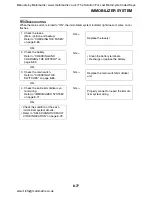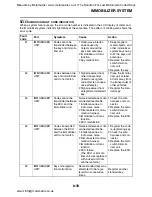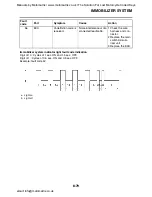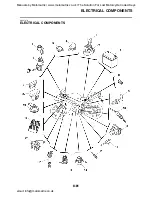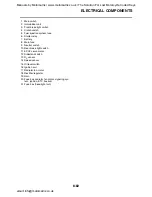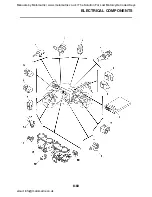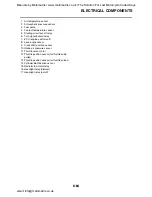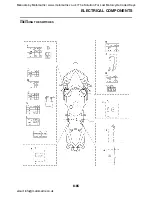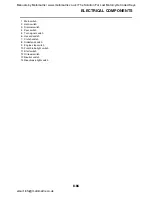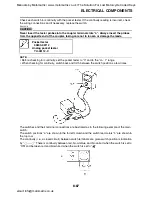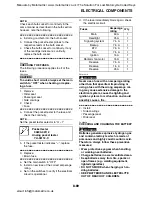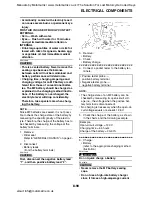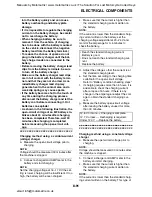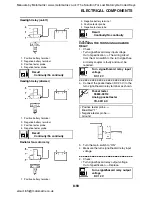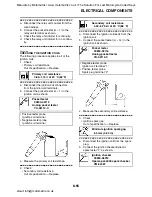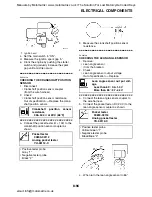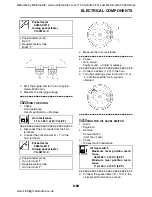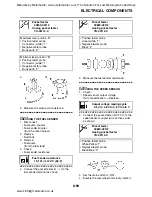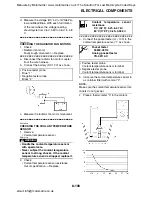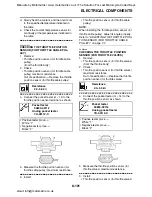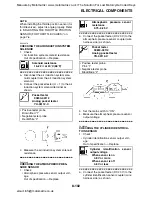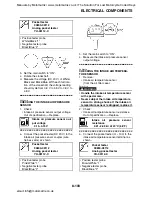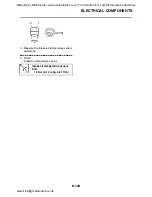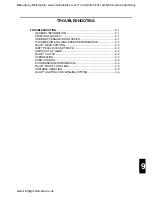
ELECTRICAL COMPONENTS
8-91
into the battery quickly and can cause
battery overheating and battery plate
damage.
• If it is impossible to regulate the charging
current on the battery charger, be careful
not to overcharge the battery.
• When charging a battery, be sure to
remove it from the vehicle. (If charging
has to be done with the battery mounted
on the vehicle, disconnect the negative
battery lead from the battery terminal.)
• To reduce the chance of sparks, do not
plug in the battery charger until the bat-
tery charger leads are connected to the
battery.
• Before removing the battery charger lead
clips from the battery terminals, be sure
to turn off the battery charger.
• Make sure the battery charger lead clips
are in full contact with the battery termi-
nal and that they are not shorted. A cor-
roded battery charger lead clip may
generate heat in the contact area and a
weak clip spring may cause sparks.
• If the battery becomes hot to the touch at
any time during the charging process,
disconnect the battery charger and let the
battery cool before reconnecting it. Hot
batteries can explode!
• As shown in the following illustration, the
open-circuit voltage of an MF battery sta-
bilizes about 30 minutes after charging
has been completed. Therefore, wait 30
minutes after charging is completed
before measuring the open-circuit volt-
age.
▼▼▼▼▼▼▼▼▼▼▼▼▼▼▼▼▼▼▼▼▼▼▼▼▼▼▼▼▼▼
Charging method using a variable-current
(voltage) charger
a. Measure the open-circuit voltage prior to
charging.
NOTE:
Voltage should be measured 30 minutes after
the machine is stopped.
b. Connect a charged and AMP meter to the
battery and start charging.
NOTE:
Set the charging voltage at 16–17 V.If the set-
ting is lower, charging will be insufficient. If too
high, the battery will be over-charged.
c. Make sure that the current is higher than
the standard charging current written on
the battery.
NOTE:
If the current is lower than the standard charg-
ing current written on the battery, set the
charging voltage adjust dial at 20–24 V and
monitor the amperage for 3–5 minutes to
check the battery.
d. Adjust the voltage so that the current is at
the standard charging level.
e. Set the time according to the charging time
suitable for the open-circuit voltage.
Refer to “Battery condition checking steps”.
f.
If charging requires more than 5 hours, it is
advisable to check the charging current
after a lapse of 5 hours. If there is any
change in the amperage, readjust the volt-
age to obtain the standard charging cur-
rent.
g. Measure the battery open-circuit voltage
after leaving the battery unused for more
than 30 minutes.
▲▲▲▲▲▲▲▲▲▲▲▲▲▲▲▲▲▲▲▲▲▲▲▲▲▲▲▲▲▲
▼▼▼▼▼▼▼▼▼▼▼▼▼▼▼▼▼▼▼▼▼▼▼▼▼▼▼▼▼▼
Charging method using a constant voltage
charger
a. Measure the open-circuit voltage prior to
charging.
NOTE:
Voltage should be measured 30 minutes after
the machine is stopped.
b. Connect a charger and AMP meter to the
battery and start charging.
c. Make sure that the current is higher than
the standard charging current written on
the battery.
NOTE:
If the current is lower than the standard charg-
ing current written on the battery, This type of
• Reach the standard charging current
Battery is good.
• Does not reach the standard charging cur-
rent
Replace the battery.
12.8 V or more --- Charging is complete.
12.7 V or less --- Recharging is required.
Under 12.0 V --- Replace the battery.
Manuals by Motomatrix / www.motomatrix.co.uk / The Solution For Lost Motorcycle Coded Keys
email: [email protected]
Содержание YZF-R1 2007
Страница 129: ...Manuals by Motomatrix www motomatrix co uk The Solution For Lost Motorcycle Coded Keys email info motomatrix co uk ...
Страница 327: ...Manuals by Motomatrix www motomatrix co uk The Solution For Lost Motorcycle Coded Keys email info motomatrix co uk ...
Страница 439: ...Manuals by Motomatrix www motomatrix co uk The Solution For Lost Motorcycle Coded Keys email info motomatrix co uk ...

